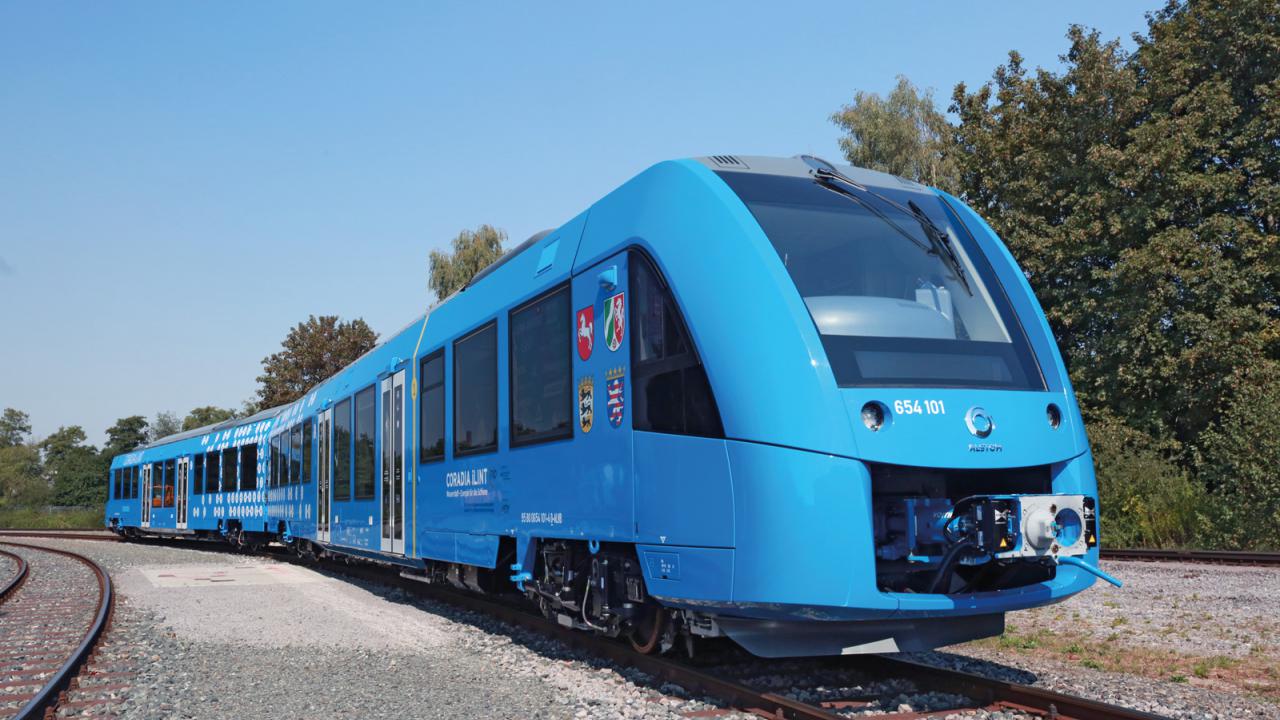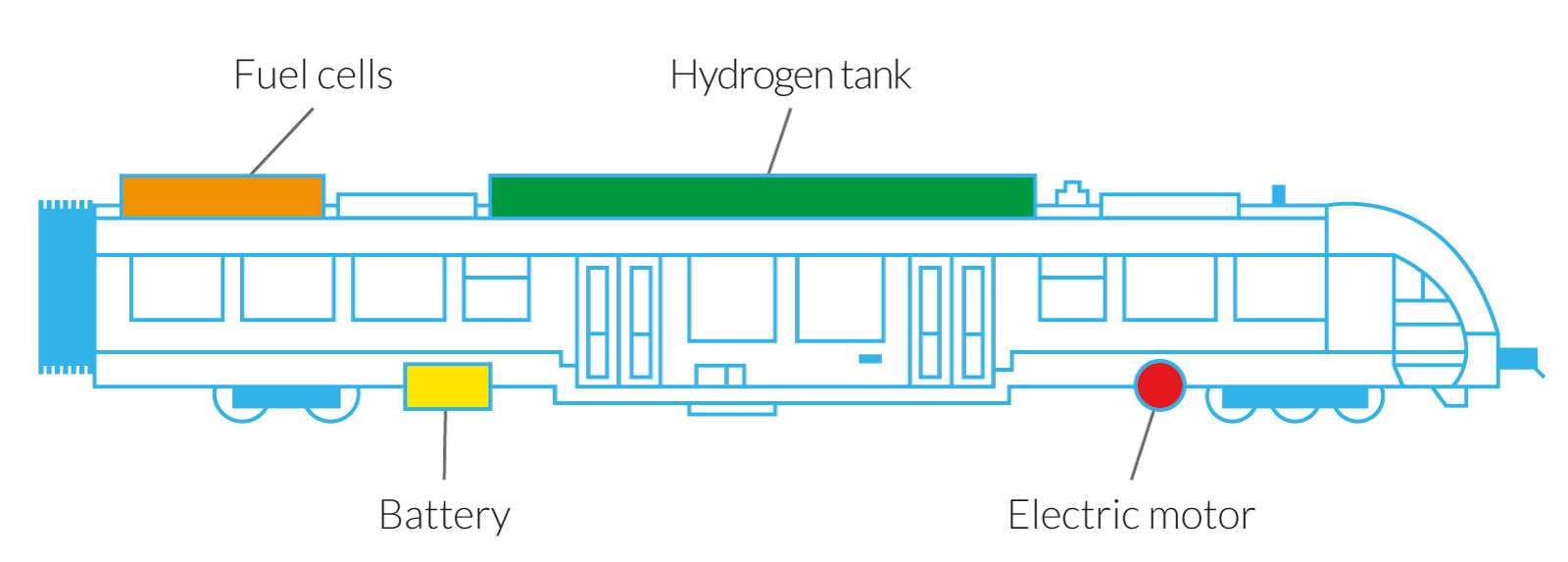
Trains powered by fuel cells are emission-free and do not require overhead power lines. Travelling along non-electrified routes, they offer a sustainable alternative to diesel vehicles. Of the almost 40,000 kilometres covered by Germany‘s rail network, around 60 percent is electrified with overhead lines. These provide the train’s electric motors with power. If this electricity comes from renewable sources, this means that rail transport on electrified main and high-speed routes can be carbon dioxide and pollutant free. The situation is different on regional and branch lines, which often have no overhead lines due to the expense of electrification; trains with diesel engines are required to run along these sections of track. As with road transport, this causes climate-damaging and environmentally harmful emissions in the form of carbon dioxide, nitrogen oxides and soot particles.
Research at the interface between energy and transport
The future of rail transport – fuel cells instead of diesel
In the quest for an efficient and sustainable alternative to diesel vehicles, the DLR Institute of Vehicle Concepts in Stuttgart is working together with industry on research into fuel-cell-powered trains specially designed to meet the requirements of rail transport. On board the train is the fuel-cell system itself, together with hydrogen tanks, a battery and electric motors. A chemical reaction takes place in the fuel cell, where hydrogen reacts with oxygen and electricity is generated. This drives the electric motors. The battery stores energy recovered during braking, helps with peak loads and ensures that the fuel-cell system can be operated under optimum conditions – meaning efficiently and at constant power. “The high power outputs and compact design that are possible today mean that fuel cells have massive potential as low-emission, flexible and efficient technology for the rail sector,” says Joachim Winter, a train researcher and Head of DLR’s Next Generation Train (NGT) project. With its range of up to 1000 kilometres, Winter sees regional and freight transport as the prime area of application for this technology. Purely battery-based concepts can cover short nonelectrified routes. However, the much higher weight and long charging times involved are drawbacks.

Comprehensive DLR expertise for industry and policymakers
From the conception of the fuel-cell power unit to realistic component tests on special test benches, the installation of a new powertrain in demonstration trains and the monitoring of the first test journeys, DLR has already contributed its expertise in technological development to support rail vehicle manufacturers in several projects. It also advises decision-makers from the fields of politics and industry about these matters. There is major interest from industry players and regional public transport authorities; most railway companies wish to convert their trains from diesel power to fuel-cell propulsion. The state of Lower Saxony has already ordered 14 fuel-cell-powered trains, while Baden-Württemberg, Hesse and Schleswig-Holstein are currently preparing the necessary calls for tender. Two fuel-cell-driven trains manufactured as part of the National Innovation Programme Hydrogen and Fuel Cell Technology (NIP), which received scientific support from DLR, have already been given green light. These regional trains have been undergoing testing since autumn 2016 and are scheduled to start running passenger services from Cuxhaven and Buxtehude to Bremerhaven in summer 2018 – a world first. “A fuel-cell-powered drive train is currently about twice as expensive as a conventional diesel system. Prices are set to fall considerably as we get closer to series production. At the same time, we have to bear in mind that fossil fuels are becoming more expensive,” says Winter. When it comes to the technology, the train expert sees huge potential: “New combinations of materials will enable improvements in capacity and cycle stability, the systems are becoming smaller and the packaging more efficient.”
Hydrogen infrastructure – avoiding bottlenecks?
Whether for cars or trains, fuel cell technology requires its own hydrogen infrastructure. Rail transport has a decisive advantage in this respect because routes, train timings and refuelling points can be planned with great precision and well in advance. At the same time, train transport reliably consumes large quantities of hydrogen – around 200 kilograms per unit and day of use, as a rough estimate. While road transport requires a network of hydrogen refuelling stations that are as closely spaced as possible, rail transport can cope with a few, centrally located refuelling hubs. These would also be ideal sites for establishing electrolysis plants to generate hydrogen. As part of their work, the DLR researchers are developing simulation models in order to determine the size of such facilities. “Such infrastructure hubs could also be located near business parks, which often already have a hydrogen infrastructure in place or generate hydrogen as a by-product, for instance as part of the chemical processing industry,” Winter says. At the same time, he explains, these hubs and the hydrogen infrastructure created there for rail transport could also be used by fuel-cell-powered cars and buses, resulting in another interesting interface.
Sector coupling – green hydrogen – storage plus fuel
The way in which hydrogen is produced is key to sustainable, climatefriendly mobility that makes an important contribution towards implementing the Energy Transition. Only ‘green hydrogen’, produced using electricity from renewable sources such as wind or solar power, makes the complete process emission-free. Germany and its federal states have been working on solutions for storing renewable energy in the form of hydrogen for some time now. “Against this backdrop, fuel-cell-powered trains can serve as an example of the successful coupling of the energy and transport sectors,” Winter says. At present, green hydrogen is not competitive due to high taxes and duties. One solution would be to exempt fuel-cell-powered trains from the track pricing that generally applies to the use of railway infrastructure.
This article is from our DLRmagazine
